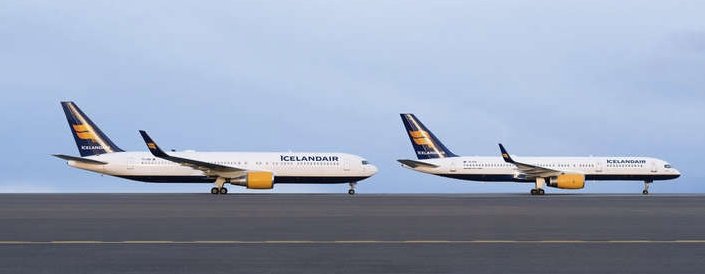To support growing demand across its European and North American networks, Icelandair is to add further capacity into its operation through the addition of further Boeing 767 equipment. The airline recently introduced the first of two aircraft that will enter service this summer and is seeking to acquire another two aircraft to grow its offering from early 2017.
Icelandair introduced the Boeing 767 back into its passenger service at the start of this month, around ten years since the carrier last utilised the type on its scheduled route from its hub at Keflavik International Airport. It is using the aircraft in the summer 2016 schedule into major European markets such as Amsterdam and London as well as to Boston, Chicago, Minneapolis, New York and Toronto in North America.
A second aircraft is scheduled to enter service from May 15, 2016 and together the two 767s have directly replaced two smaller 757-200s which were retired from service over the winter schedule at the end of their leases.
It had previously utilised the 767 on its scheduled network in summer 2005 and 2006 when the type was used to operate routes from Keflavik to Boston and San Francisco and occasional rotations within Europe to Copenhagen, Frankfurt, London, Oslo and Paris.
Deals for the two additional aircraft are expected to be concluded over the next couple of months and will enter operation early next year after being modified into Icelandair configuration. They will provide further capacity growth in key markets being configured with 262 seats versus the 183-seats currently offered on the single-aisle 757-200 which has been the backbone of the Icelandair fleet for many years.

“Operating one type of aircraft has been very economical for Icelandair but when the route network and the fleet reaches a certain size it becomes more feasible to have a broader range of aircraft in the fleet. High load factors all year round and limited number of landing slots on certain airports also support this decision,” said Björgólfur Jóhannsson, president and chief executive officer, Icelandair Group:
"We foresee further growth opportunities in the coming years with these changes to the fleet policy for passenger aircraft. The Boeing 767 aircraft can service markets that the current fleet cannot, which will enable us to go into new markets and connect them to the current route network,” he added.
For Icelandair the 767 offers some commonality to its current 757 in terms of maintenance and crew training and the airline has experience in operating that type. Alongside its previous scheduled operations Icelandair Group’s charter subsidiary, Loftleidir Icelandic, has operated the type in leasing projects that have been maintained and supported by Icelandair.
The configuration of the 767s will mainly boost the airline’s Economy Comfort and Economy offer with a 47 percent increase in capacity from 161 to 237 seats. The Business Class cabin will increase by just three seats from 22 to 25, a 12 percent growth in its premium offering.
Since 2009, the Icelandair route network has nearly tripled in size, with a capacity increase from 1.3 million to approximately 3.7 million seats. The airline has been a catalyst in bridging North America and mainland Europe through Iceland, helping boost tourism to its home country in record numbers and despite its at time chilly environment, has made it one of Europe’s hottest and fastest growing destinations.
Icelandair’s successful business model is now being rivalled in the Transatlantic market by low-cost carrier WOWair which last summer inaugurated flights into the US and this year is expanding its North America offer with additional west coast services in the US and flights into Canada. Its growth is being supported by the introduction of its first Airbus A330 widebodies this summer.




